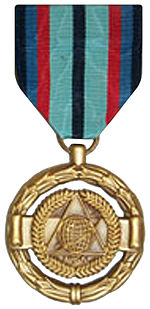NASA Exceptional Achievement Medal: Difference between revisions
m →Selected recipients by year: name added |
|||
| Line 49: | Line 49: | ||
* David Rochblatt, [[Jet Propulsion Laboratory]] Engineer, 1995 ([[NASA Exceptional Service Medal]], 2012) |
* David Rochblatt, [[Jet Propulsion Laboratory]] Engineer, 1995 ([[NASA Exceptional Service Medal]], 2012) |
||
* Jon T. Adams, [[Jet Propulsion Laboratory]], NASA Scatterometer Radio Frequency Subsystem, 1997 |
* Jon T. Adams, [[Jet Propulsion Laboratory]], NASA Scatterometer Radio Frequency Subsystem, 1997 |
||
* Richard R. Fisher, Nasa scientist, 2000 |
|||
* Gary A. Flandro, [[University of Tennessee]], UTSI, 1998 |
* Gary A. Flandro, [[University of Tennessee]], UTSI, 1998 |
||
* Joan Feynman, [[Jet Propulsion Laboratory]], 2002 |
* Joan Feynman, [[Jet Propulsion Laboratory]], 2002 |
||
Revision as of 19:46, 17 March 2016
| NASA Exceptional Achievement Medal | |
|---|---|
 | |
| Type | Medal |
| Country | United States |
| Eligibility | Government employees only |
| Status | Active |
| Established | 1991 |
NASA Exceptional Achievement Ribbon | |
| Precedence | |
| Next (higher) | Outstanding Leadership Medal |
| Equivalent | Outstanding Service Medal (obsolete) Exceptional Service Medal |
| Next (lower) | Exceptional Scientific Achievement Medal Exceptional Engineering Achievement Medal Exceptional Technology Achievement Medal Exceptional Administrative Achievement Medal Equal Employment Opportunity Medal |
The NASA Exceptional Achievement Medal is an award of the National Aeronautics and Space Administration established in 1991. The medal is awarded to both civilian members of NASA and military astronauts.
To be awarded the medal, a NASA employee must make substantial contributions characterized by a substantial and significant improvement in operations, efficiency, service, financial savings, science, or technology which directly contribute to the mission of NASA. For civilians, the decoration is typically bestowed to mid-level and senior NASA administrators who have supervised at least four to five successful NASA missions. Astronauts may be awarded the decoration after two to three space flights.
Due to its prestige, the medal is authorized as a military decoration for display on active duty military uniforms upon application from the service member to the various branch of the military in which they serve.
Notable recipients
- Chris Adami, Jet Propulsion Laboratory, physicist
- Richard Arenstorf, Vanderbilt University, mathematician
- Gordon Cooper, astronaut
- Carl Sagan, astronomer
- Alan Shepard, astronaut
- Harold "Sonny" White, aerospace engineer
- John Young, astronaut
- Charles L. Bennett, observational astrophysicist
Selected recipients by year
There are usually more than 100 recipients of this medal annually. For example, there were 177 recipients in 2010.
- Prem Chand Pandey, Jet Propulsion Laboratory, 1985 (NASA Certificate of Recognition and Cash Award)
- David Rochblatt, Jet Propulsion Laboratory Engineer, 1995 (NASA Exceptional Service Medal, 2012)
- Jon T. Adams, Jet Propulsion Laboratory, NASA Scatterometer Radio Frequency Subsystem, 1997
- Richard R. Fisher, Nasa scientist, 2000
- Gary A. Flandro, University of Tennessee, UTSI, 1998
- Joan Feynman, Jet Propulsion Laboratory, 2002
- Kevin Delin, Jet Propulsion Laboratory, Sensor Web Inventor, 2004
- Keith Presson, Marshall Space Flight Center MPLM Project Office, 2005
- Carlos Ortiz Longo, Johnson Space Center, 2005
- Robert Sherwood, Jet Propulsion Laboratory, Autonomous Sciencecraft Project Manager, 2005
- Michael Dalton, Kennedy Space Center, Computer Systems Engineer, 2007
- Michael A. Gross, Jet Propulsion Laboratory, Phoenix Project Payload Manager, 2009
- Ryan M. Lien, Johnson Space Center, Lead ISS CAPCOM Increment 17, 2009
- Eric Becker, Armstrong Flight Research Center, Deputy Director of Flight Operations, 2009
- Jonathan H. Jiang, Jet Propulsion Laboratory, Research Scientist, 2010
- Gustavo Carreno, Armstrong Flight Research Center, Avionics Supervisor, 2011
- Philip Hall, Armstrong Flight Research Center, Global Hawk Deputy Project Manager, 2011
- Eddie Zavala, Armstrong Flight Research Center, SOFIA Program Manager, 2011
- Patrick Hogan Ames Research Center, NASA WorldWind Project Manager, 2012
- Brett A. Smith, Jet Propulsion Laboratory, Dawn Attitude Control Team Leader, 2013
- Timothy P. Ferris, Kennedy Space Center, Reinvigorating the KSC Visitor Complex, 2014
- Rodney N. Phillips, Marshall Space Flight Center, Structural Dynamics Test Engineer, 2006
- Stephen D. Van Genderen, Kennedy Space Center, Thermal Fluids Systems Analysis Engineer, 2014
- Guy T. Noffsinger, NASA Headquarters, Senior Television Producer - NASA Television, 2015
- Justin C. Pane, Ames Research Center, Contracting Officer, 2015
- David K. Tow, Armstrong Flight Research Center, Range Systems Engineer, 2015
